Packing Tips for Moving


Packing Tips for Moving
If you've decided to pack up the contents of your home on your own, the packing process will be one of the most physically and emotionally demanding parts of the moving process.
Don't despair, however. Many people have successfully packed their belongings and relocated both locally and across the country - and you will be one of them!
Follow the tips and tricks below to ensure that you remain calm during the packing process and that both you and your things arrive to your destination in one piece.
- Before beginning the packing process, make sure that you have the sufficient supplies necessary to pack your belongings as carefully as possible. Necessary supplies include: boxes, marking pens, bubble wrap, newspaper, packing tape, scissors and a tape measure. If you plan on packing your own dishes, it is also recommended to purchase special boxes designed for packing dishes.
- The best place to begin the packing process is to determine what items do not need to be packed. Specifically, what items can be donated or thrown away before the move? If you have trouble getting rid of things, you are not alone. Enlist a friend to help you part with your possessions, so that you can begin your new life clutter-free. Don't be afraid to get rid of broken items, clothing that is outdated or not your size or things that you never really liked but were afraid to part with. An unbiased friend will help you to honestly evaluate all items in question so that you can purge your home of everything that you don't really need or want. After all, why spend money to move things that you don't love?
- After you've established what you're not taking, begin the packing process by packing things that you don't use on a regular basis. If you own a large collection of books, this may be a great thing to pack first. Or, if you're moving in the winter, you may want to start by packing your summer clothing. By packing lesser-used items first, you can start the packing process as early as possible and avoid unnecessary rushing as the move nears.
- Keep a detailed list of what was packed in each box. This list is important because it will streamline the unpacking process and make it easier for you to notice if something went missing during the move.
- Even if you're not packing fragile items like your computer by yourself, you'll probably want to backup all of your important files to protect your data in the unlikely event that your computer breaks during the move.
- You may also want to photocopy your important documents such as the birth certificates and social security cards of your family members so that you'll have a copy in case the originals get lost (even temporarily) during the move.
- After you've made the copies, pack all of your important copied documents in one place so that they stay together and are easy to recognize when you are unpacking. The originals should be taken in your hand luggage whenever possible.
- Do not fill packing boxes with items totaling more than 50 pounds. Doing so will be uncomfortable to carry and may cause boxes to break.
- To ensure the security of all items within a box, make sure to tape boxes securely at the bottom.
- When packing a box with a variety of items, place heavier items at the bottom of the box. This will prevent the heavy items from crushing lighter things.
- Store lightweight items inside larger items. Pack pillows into your dresser drawers, for example. This will save valuable space and make it easier to unpack.
- Even if you've hired a mover to do the bulk of the work, make sure to pack your jewelry yourself. When it's all packed, it's a good idea to take it in your hand luggage rather than to stuff it into a moving box.
- Consider using a wardrobe box to pack clothing that hangs in your closet. This will prevent the clothing from wrinkling and will enable you to pack it directly on the hanger, so that you won't need to rehang the clothes upon arrival. Likewise, a wardrobe box is an efficient way to move curtains -- simply fold the curtains neatly and hang them on a hanger, for wrinkle-free moving.
- A great way to visibly determine which box goes where upon arrival is to color code your moving boxes whenever possible. One way to do this is by labeling the boxes with colored permanent markers. Alternatively, placing colored tape or stickers on the boxes will enable you to determine with a quick glance whether a box goes in the master bedroom or the dining room.
- Another way to stay organized is to pack your home one room at a time whenever possible. Doing so will make it easier to unpack things in the right place and will keep you focused during the packing process. Packing up room-by-room will also make the packing process seem more manageable as you'll be able to keep a clear eye on exactly what needs to be done.
- When possible, pack items in their original box. If you've saved the box from your television, for example, use it to transport your TV safely.
- If you are packing an item with small parts, screws or wires, tape the loose items to the back of the bigger item to prevent them from getting lost or tangled. If possible, use duct tape or another type of strong tape that will be secure enough to hold your things but relatively easy to remove.
- Pack all liquids in containers that seal securely.
- Household appliances that require liquids to function (such as steam irons or gasoline-powered lawn movers) should be drained before the move.
- In the winter, try not to pack any liquids that may freeze during transport.
- When packing furniture, make sure to wrap the body of the furniture as well as the legs.
- If you are moving across state lines, make sure to contact the State Veterinarian or the State Department of Animal Husbandry to make sure that your pet's vaccines and licensing requirements conform to the laws in your new state.
- Likewise, if you want to relocate your house plants, it is recommended to call the US Department of Agriculture to confirm whether you can bring your plants to your new home. Some states such as California and Florida are concerned about insects that may be brought in that can affect their commercial agricultural growth.
- Pack books, CDs, and records on end -- do not stack them.
- Dishes should be packed with packing paper between each dish. For best results, purchase protected boxes that are designed to move dishes, so that your fragile items will be protected from all angles.
- Drinking glasses should be wrapped and stuffed with paper.
- Take care to check every piece of packing paper while unpacking, to avoid accidentally throwing out a glass or small fragile item.
